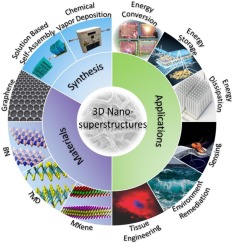当前位置:
X-MOL 学术
›
Nano Today
›
论文详情
Our official English website, www.x-mol.net, welcomes your
feedback! (Note: you will need to create a separate account there.)
Three dimensional nanosuperstructures made of two-dimensional materials by design: Synthesis, properties, and applications
Nano Today ( IF 13.2 ) Pub Date : 2019-12-01 , DOI: 10.1016/j.nantod.2019.100799 Weigu Li , Yun Huang , Yifei Liu , Marshall C. Tekell , Donglei (Emma) Fan
Nano Today ( IF 13.2 ) Pub Date : 2019-12-01 , DOI: 10.1016/j.nantod.2019.100799 Weigu Li , Yun Huang , Yifei Liu , Marshall C. Tekell , Donglei (Emma) Fan

|
Abstract The recent search for advanced materials with desired properties for next-generation flexible energy and electronic devices has focused on the unique class of two-dimensional (2D) materials made of layered crystalline structures. In particular, intensive interest has been devoted to configuring 2D materials into three-dimensional (3D) nanoporous superstructures (3DSs), which can effectively prevent aggregative restacking and maximize the exposure of active nanoscale planar surfaces. Here, we survey the recent progress of 3DSs made of several important 2D materials, including graphene, boron nitride (BN), transition metal dichalcogenide (TMD), and transition metal carbide/carbonitride (MXene). The characteristics of the formed 3DSs, including density, porosity, electrochemical activity, electronic and surface properties, depend on respective synthesis approaches and conditions. The obtained 3DSs, exhibiting distinctive properties, have been exploited in an array of applications, including shielding electromagnetic, thermal, and acoustic energies; sensing chemical, optical, and mechanical signals; serving as 3D scaffolds of energy and environment devices; and supporting 3D growth of live cells and tissues. At the end, this comprehensive review is summarized with future outlooks, including the great potentials, challenges, and bottleneck issues in fabrication and large-scale implementation of 3DSs.
中文翻译:

通过设计由二维材料制成的三维纳米超结构:合成、性质和应用
摘要 最近对具有下一代柔性能源和电子设备所需特性的先进材料的研究集中在由层状晶体结构制成的独特类型的二维 (2D) 材料上。特别是,人们对将 2D 材料配置成三维 (3D) 纳米多孔超结构 (3DSs) 产生了浓厚的兴趣,这可以有效地防止聚集重新堆叠并最大限度地暴露活性纳米级平面表面。在这里,我们调查了由几种重要的 2D 材料制成的 3DS 的最新进展,包括石墨烯、氮化硼 (BN)、过渡金属二硫属化物 (TMD) 和过渡金属碳化物/碳氮化物 (MXene)。形成的 3DS 的特性,包括密度、孔隙率、电化学活性、电子和表面特性,取决于各自的合成方法和条件。获得的 3DS 具有独特的特性,已在一系列应用中得到利用,包括屏蔽电磁能、热能和声能;感应化学、光学和机械信号;作为能源和环境设备的3D支架;并支持活细胞和组织的 3D 生长。最后,这篇综合评论总结了未来展望,包括 3DS 制造和大规模实施的巨大潜力、挑战和瓶颈问题。作为能源和环境设备的3D支架;并支持活细胞和组织的 3D 生长。最后,这篇综合评论总结了未来展望,包括 3DS 制造和大规模实施的巨大潜力、挑战和瓶颈问题。作为能源和环境设备的3D支架;并支持活细胞和组织的 3D 生长。最后,这篇综合评论总结了未来展望,包括 3DS 制造和大规模实施的巨大潜力、挑战和瓶颈问题。
更新日期:2019-12-01
中文翻译:

通过设计由二维材料制成的三维纳米超结构:合成、性质和应用
摘要 最近对具有下一代柔性能源和电子设备所需特性的先进材料的研究集中在由层状晶体结构制成的独特类型的二维 (2D) 材料上。特别是,人们对将 2D 材料配置成三维 (3D) 纳米多孔超结构 (3DSs) 产生了浓厚的兴趣,这可以有效地防止聚集重新堆叠并最大限度地暴露活性纳米级平面表面。在这里,我们调查了由几种重要的 2D 材料制成的 3DS 的最新进展,包括石墨烯、氮化硼 (BN)、过渡金属二硫属化物 (TMD) 和过渡金属碳化物/碳氮化物 (MXene)。形成的 3DS 的特性,包括密度、孔隙率、电化学活性、电子和表面特性,取决于各自的合成方法和条件。获得的 3DS 具有独特的特性,已在一系列应用中得到利用,包括屏蔽电磁能、热能和声能;感应化学、光学和机械信号;作为能源和环境设备的3D支架;并支持活细胞和组织的 3D 生长。最后,这篇综合评论总结了未来展望,包括 3DS 制造和大规模实施的巨大潜力、挑战和瓶颈问题。作为能源和环境设备的3D支架;并支持活细胞和组织的 3D 生长。最后,这篇综合评论总结了未来展望,包括 3DS 制造和大规模实施的巨大潜力、挑战和瓶颈问题。作为能源和环境设备的3D支架;并支持活细胞和组织的 3D 生长。最后,这篇综合评论总结了未来展望,包括 3DS 制造和大规模实施的巨大潜力、挑战和瓶颈问题。











































 京公网安备 11010802027423号
京公网安备 11010802027423号